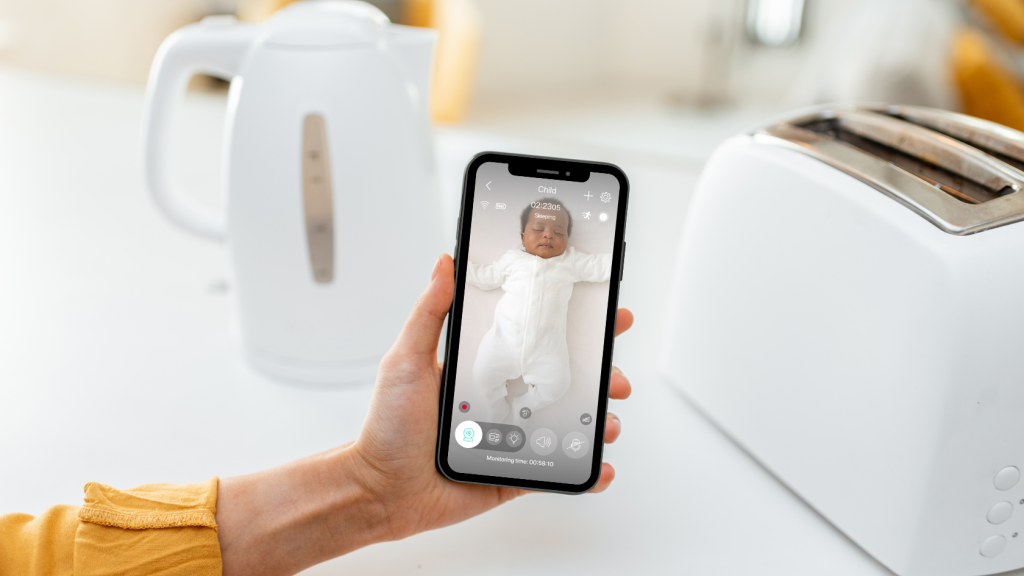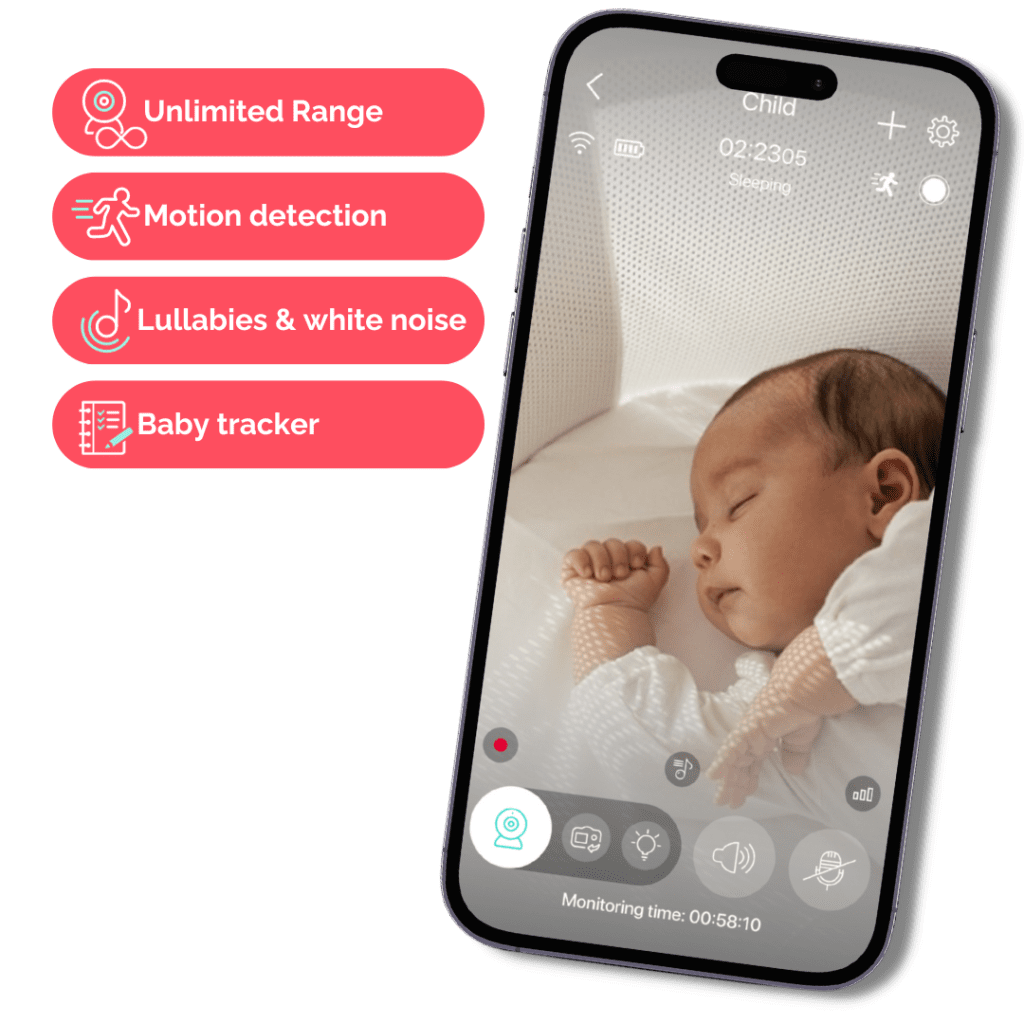
How to Make Sure Your Baby Sleeps Safely? Try the ABCs of Sleep
- Created:
10. 1. 2023 - Updated:
15. 2. 2024
Here’s the thing:
Rarely, sudden infant death syndrome (SIDS) occurs in sleep during the first year of life.
Luckily…
The ABCs method offers effective prevention. It is possible to reduce the risk of SIDS to a minimum by taking a few simple steps.
Aside from that…
Based on scientific validation, the following recommendations have been proven effective.
The ABCs of Sleep Safety for Baby
According to the American Academy of Pediatrics (AAP), parents can promote safer sleep for infants by following the ABCs of safe sleep. Keeping a baby safe while sleeping is as simple as A, B, C: Alone, Back and Crib. Baby should always sleep alone. Baby should sleep on their back. And last but not least, the baby should always sleep in a crib.
ABCs Method Close-Up
Babies should always be put down alone on their back in their crib.
Meaning of A: alone
Make sure baby sleeps alone – never with an adult, another child, a twin, or anyone else.
The baby should sleep in a safe crib near the parent.
💡 TIP:
You can let your baby sleep alone if you have a reliable baby monitor. Check out our review of the best baby monitors in 2022.
Meaning of B: back
Place baby to sleep on their back.
If a baby sleeps on its stomach or side, the risk of SIDS increases.
You can let your baby sleep on his tummy or side as soon as rolls over during sleep.
💡 TIP:
To reduce SIDS it is recommended to get a baby monitor or a breathing monitor. Preferably both. Read why it is beneficial to have a baby sleep tracker.
Meaning of C: crib
A safe crib with a snug mattress and tight-fitting sheet is best for a baby to sleep in.
Baby should not have anything in their crib with them – no pillows, no blankets, no quilts, no bumper pads, no soft toys, no stuffed animals, no sheepskins, no comforters, etc.
Replace blankets with a sleep sack, sleepingbag or one-piece sleeper.
It isn’t safe for a baby to sleep on a couch, adult bed, bean bag, air or soft mattress.
Swings, recliners, infant seats, car seats, Rock and Plays, and other infant care products that are not cribs, bassinets, or play yards should not be used to put a baby to sleep.
💡 TIP:
Baby sometimes refuses to sleep for some obscure reason. Find out the causes and solutions why baby refuses to sleep alone in the crib.

Safe Sleep Tips for Babies
Know this:
Even with years of research efforts by doctors and other experts, it is not currently possible to determine which babies are more at risk of SIDS.
However…
There are safe sleep tips for babies that can help minimize the risk of SIDS.
Baby Sleeping Bag Instead of a Blanket
Please…
Do not put any blankets or pillows in the crib. This is important as your baby will not put his/her head under them and thus put himself/herself at risk.
A suitable baby sleeping bag cannot be unzipped or pulled over the head.
Help to determine the correct size of sleeping bag:
Baby body size plus 4 inches in all directions. The neck opening must not be larger than the head circuit. There are already special sleeping bags for newborns.
💡 TIP:
Sound sleep is essential for the baby’s overall growth and development. One way to ensure sound sleep for newborns is swaddling. Learn how to swaddle a baby step by step.
The AAP recommends parents stop swaddling when the baby starts to roll over, which can happen as early as 2 to 3 months.
The reason:
When a baby rolls over onto his tummy, he doesn’t have free hands to lift and free his face to breathe.
Try a Pacifier
Know this:
Existing research has shown that it is possible to reduce the risk of SIDS by giving your baby a pacifier to sleep with.
Here’s the thing:
It is not yet clear exactly what causes the fact that the presence of a pacifier contributes to safer sleep for babies.
Look:
One possible reason is that when a pacifier is in the baby’s mouth, it is less likely that the baby will roll over when they are sleeping. Baby is simply calmer.
A second explanation is that the physiological process of sucking on a pacifier keeps the tongue in a firm, upright position that allows air to pass freely through the mouth and nasal cavity. A pacifier may prevent the child from entering very deep stages of sleep, thereby reducing the risk of SIDS, by triggering the sucking reflex.
However:
This is not the rule. If the baby falls into deep sleep, the pacifier will fall out of the baby’s mouth.
💡 TIP:
Research suggests non-nutritive sucking, such as on a pacifier, may support healthy baby sleep. Find out what the benefits of sleeping with a pacifier are.
Monitor Baby’s Breathing
Here’s the thing:
The absolutely most effective prevention of SIDS is the use of a breath monitor, ideally, one that is certified as a medical device.
Look:
A breath monitor is a monitoring device that continuously detects a child’s breathing movements. And sounds an audible and visual alarm when it detects life-threatening slowing, irregularity, arrest or apneic pause (breathlessness).
It can thus call for help in time to protect the child’s life.
💡 TIP:
With medically-certified baby breathing monitors, you have the assurance that your child is getting a safe night’s sleep. Choose a trusted baby breathing monitor that has been clinically tested.
Keep an Eye on Your Baby Constantly
Did your little one fall asleep for a while?
Keep an eye on the sleeping baby while you let him sleep in the bedroom with a reliable baby monitor.
Meanwhile …
You can focus on your home, older siblings or a well-earned rest.
Don’t worry:
When the baby wakes up, the smart baby monitor will alert you with a sound.
But not only that:
Today’s baby monitors offer audio and video streaming. App connectivity to your mobile phone. Or you can keep your parenting unit with you at all times in the form of a watch.
Keep in mind:
When choosing a baby monitor, your first concern should be its range. With a smart baby monitor, you get unlimited range, as long as you have a reliable internet connection, of course. The app on your phone then serves as a parental unit with video and audio capabilities.
💡 TIP:
When choosing a baby monitor, it is crucial to consider several important factors. We evaluate each model according to these criteria to determine the best baby monitor.
Protection Against Overheating
Know this:
Keep the temperature in your bedroom to a maximum of 64.4° Fahrenheit, even in winter.
An ideal bedroom temperature is 16 °C to 18 °C.
Understand this:
Your baby’s hands and feet may be cold. This does not mean baby is cold. Once the baby is sweating around the neck, the room is too overheated.
Now:
All your baby needs to sleep is a nappy, onesie, pyjamas and a sleep sack. If the room temperature is high (especially in summer), baby needs even less.
Also:
Make sure that your baby’s head is not covered during sleep. Babies who have their heads covered with something have been found to be at much higher risk of SIDS. Also, the baby needs his head bare so he can regulate body temperature.
Lastly:
If water bottles and heating blankets are necessary, they must only be used to pre-warm the crib. They are not necessary for sleep and are even dangerous. Fur pads or similar items do not belong in the crib either.
Keep Breastfeeding Up if Possible
Look:
Breastfeeding has been shown to have a great effect on boosting a baby’s immune system against disease and infection, among many other positive effects.
Know this:
Current research has so far found evidence of the effect of breastfeeding on reducing the risk of SIDS in babies during the first 12 months of life.
Hence:
If at all possible, it is recommended that mothers breastfeed their babies for 12 months and exclusively breastfeed for at least the first 6 months.
One more thing:
During the night, you can breastfeed your baby in your bed, but make sure that you place them back in their own sleep area once you have finished.
Smoking Cigarettes Is Harmful
Here’s the thing:
Babies whose mothers smoked during pregnancy are 3 times more likely to develop SIDS than other babies.
Also …
Similarly, exposing babies to passive smoking in the presence of parents or other adults contributes to the same effect.
Look:
Studies show that the presence of each additional smoker in the household contributes to the risk of SIDS.
Studies also point to ‘third-hand smoke’, where the child comes into contact with smoke trapped in clothing, in the home, etc.
Therefore:
It is very important for babies to be in an environment that is completely and totally smoke-free. This protects them not only against SIDS but also against a whole range of breathing diseases.
Final Tip: Annie Baby Monitor – A Guardian for Safe Sleep
Keep an eye on your sleeping babyconstantly, and make sure they’re safe at all times. Check out Annie Baby Monitor.
This awesome baby monitor app has everything you need to keep an eye on your little one’s safety. You get live video and audio monitoring plus instant alerts if anything – it detects motion, sound, and crying.

With Annie by your side, you can finally catch a break and relax, knowing that your little one is being looked after 24/7. So why wait? Get Annie Baby Monitor today and sleep easy tonight!
Conclusion
First thing first:
Your baby will sleep better and safer thanks to the ABC’s safe sleep method.
If you want to make sure your baby is safe when sleeping, remember to place your baby alone, on their back in a crib.
All in all:
Sudden infant death syndrome can be reduced by following these guidelines.
With that in mind, we recommend:
- Use baby sleeping bag instead of a blanket.
- Don’t put anything in the crib. NO blankets. NO pillows. NO stuffed animal.
- Give baby pacifiers at nap time and bedtime.
- Use a medically certified baby breathing monitor.
- Keep your baby under constant supervision with the help of a baby monitor.
- Keep the room temperature comfortable for a lightly clothed adult.
- To reduce SIDS, you should keep breastfeeding up to 4-6 months of baby.
- No smoking around the infant or in the infant’s environment.
- Educate everyone who cares for your baby about ABCs safe sleep – daycares, grandparents, babysitters, etc.
FAQ: The ABCs of Sleep Safety for Baby
The ABCs method of safe sleep is for babies older 5 months.
The ABCs of safe sleep is suitable for parents who want to create a sleep schedule for their little ones. ABC’s method helps babies overcome rough nights so they can sleep 10–12 hours every night.
ABCs of Sleep by Cara is an online training course. It’s a 3-class collection to help your baby sleep for 10-12 hours, nap regularly, and overcome everything that comes your way. A step-by-step sleep training plan that is completely customizable and holistic.
The ABC of Sleep by Cara training course can be purchased as a subscription:
“ABCs of Sleep” for $179 USD or “Conquering Naps” for $129 USD only.
Most popular is “The 5-24 Month Collection” $249 USD.
An online course/program called Taking Cara Babies helps parents establish healthy sleep habits for their newborns.
You will learn how to calm a fussy baby, read a baby’s cues, and set your days and nights up for success with this program.
As a result of the Cara program, parents can enjoy the newborn stage to the fullest without worry.
The “Safe to Sleep”® was developed by a collaboration of four organisations: the American Academy of Pediatrics (AAP), the Health Resources and Services Administration (HRSA), First Candle (SIDS Alliance), and the Association of SIDS and Infant Mortality Programs.Specifically, the ABCs steps were created by the American Academy of Pediatrics.
























